Siemens extraklasse xl 1000 User Manual
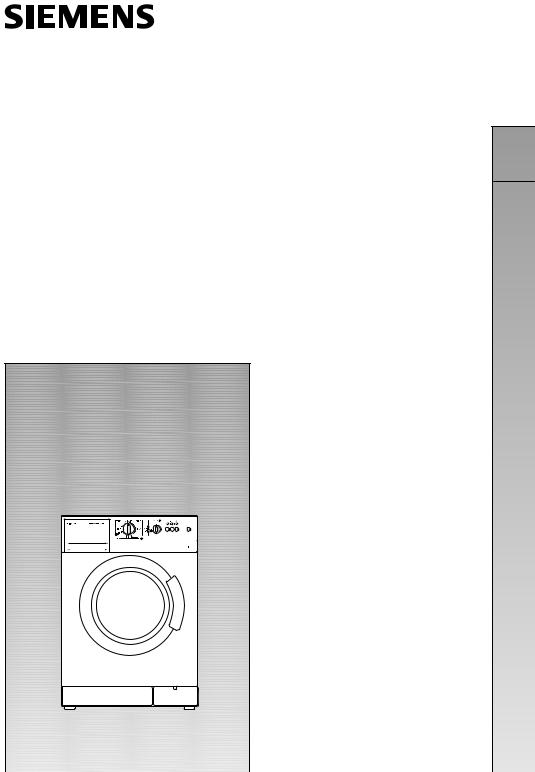
M
X R X
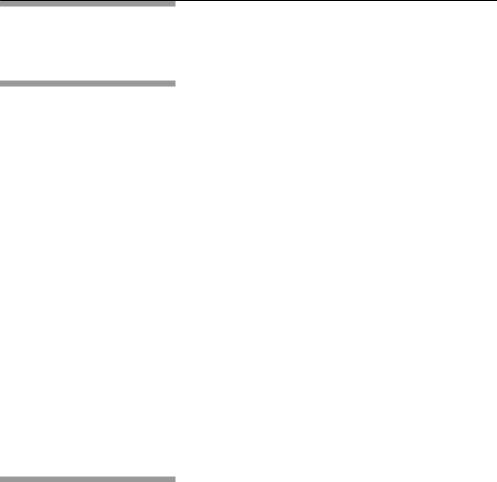
Table of Contents
Operating
Instructions
Installation
Instructions
(/-,/ ) |
+%,.* 0(,+ |
|
|
|
|
|
|
|
|
4 |
|
|
|
|
|
|
|
|
|
|||||||||||
+2(.,+*$+0 ) .,0$"0(,+ |
|
|
|
|
|
|
|
|
|
|
|
|
|
|
|
|
|
|
|
|
|
|||||||||
,+/$.2 |
0(,+ |
//1$/ |
|
|
|
|
|
|
|
|
|
|
|
|
|
|
5 |
|
|
|
|
|
|
|
|
|
|
|||
$+$. ) |
|
%$04 |
+/0.1"0(,+/ |
|
|
|
|
|
|
|
|
|
|
|
|
|
|
|
|
|
|
|
|
|||||||
,1. $3 /'(+& |
"'(+$ |
|
|
|
|
|
|
|
|
|
|
|
|
|
|
|
|
|
|
|||||||||||
$%,.$ /(+& ,1. /'(+& "'(+$ |
|
|
|
|
|
|
|
|
|
|
|
|
|
|
|
|||||||||||||||
,. |
0'$ |
(./0 (*$ |
|
|
|
|
|
|
|
|
|
|
|
|
|
|
9 |
|
|
|
|
|
|
|
|
|
||||
.$- |
.(+& |
,.0(+& |
+# |
, |
#(+& |
|
0'$ |
|
1+#.4 |
|
|
|
|
|
|
|
|
|
|
|
||||||||||
1+#.4 |
$0$.&$+0/ |
+# ##(0(2$/ |
|
|
|
|
|
|
5 |
|
|
|
|
|
|
|
|
|
||||||||||||
$)$"0(+& |
.,&. **$/ |
|
|
|
|
|
|
|
|
|
|
|
|
|
|
|
|
|
|
|
|
|
||||||||
/'(+& |
|
|
|
|
|
|
|
|
|
|
|
|
|
|
|
|
|
|
|
|
|
|
|
|
|
|
|
|
||
'$+ 0'$ .,&. **$ |
|
' / +#$# |
|
|
|
|
|
|
|
|
|
|
|
|
|
|||||||||||||||
-$"( ) |
--)(" |
0(,+/ |
|
|
|
|
|
|
|
|
|
|
|
|
|
4 |
|
|
|
|
|
|
|
|
|
|
||||
)$ +(+& |
|
+# |
|
.$ |
|
|
|
|
|
|
|
|
|
|
|
|
|
|
|
|
|
|
|
|||||||
.,1!)$/',,0(+& (+,. 1)0/ |
|
|
|
|
|
|
|
|
|
|
|
|||||||||||||||||||
1/0,*$. $.2("$ |
|
|
|
4 |
|
|
|
|
|
|
|
|
|
|
||||||||||||||||
,+/1*-0(,+ |
0$/ |
|
|
|
|
|
|
|
|
|
5 |
|
|
|
|
|
|
|
|
|
|
|||||||||
+/0 |
)) 0(,+ |
,++$"0(,+ |
+# . +/-,. 0 |
|
|
|
|
|
|
|
|
|
|
|
|
|
|
|
||||||||||||
3

Please read this instruction manual and all other information accompanying the washing machine before operating the appliance.
Please retain all |
documents for future reference or |
for a subsequent |
appliance owner. |
Disposal Information
Disposing of the packaging
Disposing of your old appliance
The shipping package has protected your new appliance on its way to your home. All packaging materials are environment$friendly and recyclable. Please contribute to a better environment by disposing of packaging materials in an environmentally conscious manner.
Please |
ask |
your dealer or local authority |
about best |
means |
of |
disposal. |
|
Danger |
of suffocation! |
|
|
Keep children away from shipping carton and |
|||
packaging components. Danger of suffocation from |
|||
plastic film and folding cartons. |
|
||
Old appliances are not worthless rubbish! |
|
||
Environment$conscious recycling can reclaim |
|
||
valuable |
raw materials. |
|
|
Danger of fatal injury! |
|
||
On out$of |
service appliances, unplug mains plug. |
||
Cut off |
power cord and discard with mains |
plug. |
|
To prevent |
playing children from becoming trapped |
||
and endangered, ensure that the door locking |
|||
mechanism |
is disabled. |
|
|
4

Environmental Protection /
Conservation Issues
Your washing machine uses water, energy and detergent efficiently, thereby protecting the environment and reducing your household costs. See Page 35 for consumption values of your appliance.
Using your washing machine in an efficient and environmentally friendly manner:
- Do not exceed the maximum load specifications:
Cottons/coloureds |
6.0 |
kg |
/ |
13.2 |
lb |
||
Easy4care |
3.0 |
kg |
/ |
6.6 |
lb |
|
|
Delicate and Wool |
2.0 |
kg |
/ 4.4 |
lb |
|||
For small amounts |
of laundry, the |
|
automatic |
water |
|||
level control system reduces the consumption of both water and energy.
-Where possible, use the °C60 • ntensive Stains" programme instead of the °C90 •Cottons/
coloureds" programme. The extended washing duration means that a cleaning result comparable to that of the°C90 programme is achieved using considerably less energy.
- Avoid using the Prewash programme when washing lightly to normally soiled laundry.
-Add detergent according to the degree of soiling, amount of laundry and water hardness, and observe the detergent manufacturer's instructions.
5

General Safety Instructions
Your washing machine is intended:
- For domestic use only.
-For washing machine$washable fabrics in washing solution.
- For operation using cold |
and hot (70 °C) tap water |
|||
and |
conventional |
laundry |
detergents |
and additives |
that |
are suitable |
for use |
in washing |
machines. |
Do not leave children unsupervised near the washing machine.
Keep pets away from the washing machine.
Do not insert/pull out the mains plug with wet hands.
Do not pull out the mains plug by tugging the cable.
Do not touch the loading door if washing at high temperatures.
Caution when draining hot water.
Do |
not |
climb |
onto the washing |
machine and do not |
lean |
on |
the |
open loading door. |
|
6

Your New Washing Machine
g d d g d dd d
D
D a
a
D
D a a a
a a
a
D
a d a
a d
d a
d
d g d |
d c |
g |
|
|
c |
7
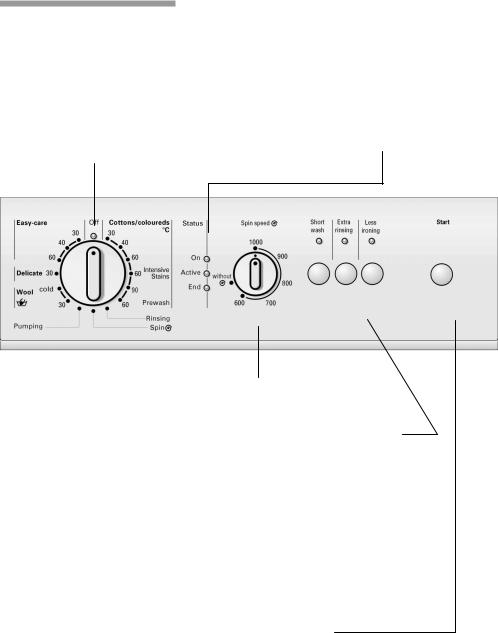
Control |
panel |
|
1. Select |
a |
programme |
Switches |
on |
/ off the washing machine |
Can be turned in both directions
The programme selector cannot be turned when the programme is in progress The pro/ gramme sequence is controlled electronically
2. Control lights illuminate
•On" when programme is selected •Active" when •Start" is pressed •End" when programme is finished
Flashing control lights = operating fault
3. Set the spin speed(if desired)
Variable; must click into place at •without4"
4. Press buttons for additional functions
(where required to supplement the programme) •Short wash" Shortened programme duration
•Extra |
rinsing" |
Additional rinsing cycle |
|
|
|||||
•Less |
|
ironing" |
Reduces |
creasing |
|
|
|
||
It |
is |
also |
possible to combine the |
additional |
functions |
||||
at |
any |
time |
|
|
|
|
|
||
The |
control |
light |
above |
the option |
button |
lights |
|||
up |
when the respective |
additional |
function |
is |
active |
||||
To cancel the additional function Press the button again
5. Press the •Start" button
The washing process begins (programme must have been selected)
8

Before Using Your Washing
Machine For the First Time
The washing machine must have been installed and connected properly (refer to Page 3 ).
Your appliance |
was |
tested before leaving |
the |
factory. |
||
To remove any water left over from testing |
|
|||||
procedures, |
the first washing cycle should be carried |
|||||
out without |
laundry |
in the machine. |
|
|
||
Do |
not |
load |
any |
laundry. |
|
|
Turn |
on |
the |
water tap. |
|
|
|
Pull |
out |
the |
detergent dispenser up to |
the |
end |
|
stop.
Pour approx. 1 litre / 1 ¾ pt of water into chamber II of the detergent dispenser.
Half fill the measuring beaker with detergent and pour into chamberII. Do not use any special detergents for delicates or woollens (excessive foam).
Close the detergent dispenser.
Set the programme selector to°C•90Cottons/ coloureds".
The •On" control light comes on.
Press the •Start" button.
The • ctive" control light comes on.
When the •End" control light comes on:
Set the programme selector to •Off".
9
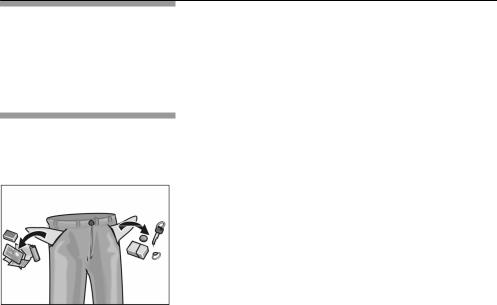
Preparing, Sorting and Loading
the Laundry
Preparing the laundry
Caution
Loose debris (e.g. coins, paper clips, needles, nails) can damage items of clothing as well as parts of the washing machine (e.g. drum).
Empty all pockets on items of clothing.
Brush out any sand from pockets and cuffs.
Close zip*fasteners and button up bed covers.
Remove curtain runners or tie them up in |
a |
net |
/ |
bag. |
|
|
|
The following items must be washed inside |
a |
net |
/ |
pillow case: |
|
|
|
-Extremely delicate items, e.g. fine tights, net curtains.
- Small items, e.g. small socks or handkerchiefs.
- Underwired bras (the wire may come loose during washing and cause damage).
When washing trousers, knitwear and woven
fabrics, e.g. shirts, |
T*shirts or sweatshirts, always |
turn these items |
inside out. |
10
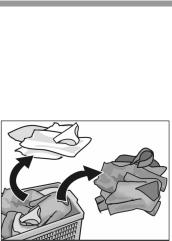
Caution
Sorting the laundry Items of clothing can become discoloured. Never wash new multi(coloured items together with other items.
According to colour and degree of dirt
White items may become grey. Always wash white and coloured items separately.
Degrees of dirt |
Slight |
|
dirt |
|
|
|
|
|
|
No recognizable dirt or staining. Laundry may have |
|||||||
|
some body |
odour. |
|
|||||
|
- |
Light summer |
clothing and sportswear that has |
|||||
|
|
only |
|
been |
worn for a |
few hours. |
||
|
- |
T(shirts, |
shirts |
and blouses that have been worn |
||||
|
|
for |
up to |
one |
day. |
|
||
|
- |
Bed |
|
linen |
and |
guest |
towels that have been used |
|
|
|
for |
one |
day. |
|
|
||
|
Normal |
dirt |
|
|
|
|||
|
Visible |
|
dirt |
and/or |
some |
light staining recognizable. |
||
|
- |
T(shirts, |
shirts |
and blouses that are very sweaty or |
||||
|
|
have |
been |
worn several times. |
||||
|
- |
Underwear |
that |
has been worn for one day. |
||||
|
- |
Tea |
|
towels, hand towels and bed linen that have |
||||
|
|
been used |
for |
up to |
one week. |
|||
|
- |
Net |
|
curtains (without nicotine staining) that have |
||||
|
|
not |
|
been |
washed for |
up to ½ year. |
||
11
Intensive dirt
Dirt and/or |
staining recognizable. |
- Kitchen |
hand towels that have been used for up to |
one week.
-Fabric napkins.
-Bibs.
-Children's outer clothing or football shirts and
shorts with grass and soil stains.
-Working clothes such as overalls or baker's and butcher's coats.
Typical stains
- Skin fat, cooking oils / fat, sauces, mineral oil, wax (containing fat / oil).
-Tea, coffee, red wine, fruit, vegetables (bleachable).
-Blood, egg, milk, starch (containing protein / carbohydrate).
-Soot, soil, sand (pigments), red sand on tennis clothes.
Removing stains
Wherever possible, remove / pretreat stains whilst they are still fresh.
First, dab soapy water onto the stain. Do not rub.
Subsequently wash the items of clothing using the appropriate programme.
Several washing cycles may sometimes be required in order to remove stubborn / dried in stains.
12
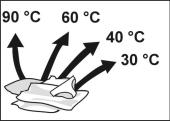
Sorting laundry according to their care label specifications
Only wash laundry that is labelled with the following care symbols:
ed
90 °C Cottons/coloureds
cba
60 °C, 40°C, 30°C Cottons/coloureds
hgf
60 °C, 40°C, 30°C Easy&care
lgkf
40 °C, 30°C Delicate
6lgkf
40 °C, 30°C Wool (hand and machine&washable)
Laundry |
that |
is |
labelled with the following care symbol |
must not be washed in the washing machine: |
|||
B = |
do |
not |
wash |
13
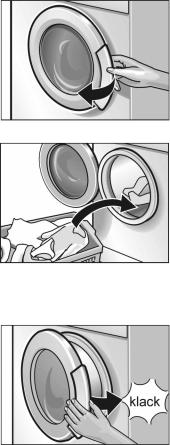
|
Risk |
of |
explosion! |
|
|
|
|
|
|||
Loading the laundryItems of |
clothing that have been |
pretreated with |
|||
|
solvent'based cleaning agents e g stain remover |
|
|||
|
and dry cleaning spirit represent |
an explosion |
hazard |
||
|
once loaded into the washing machine Therefore |
||||
|
these items |
must first be rinsed |
thoroughly by |
hand |
|
Caution
Loose debris in the washing machine drum can damage the laundry Before loading the laundry
check that there is |
no debris in the drum |
Open the loading |
door |
Unfold the sorted items of clothing and place them loosely into the drum Mix up large and small items
Items of varying size will distribute better during the spin cycle
Do not exceed the maximum load: Overloading will cause poor wash results and encourage creasing
When washing a small amount of laundry the washing machine automatically reduces the amount of water and energy used
Close the loading door
Take care not to trap any items of clothing between the loading door and rubber seal
14

Laundry Detergents
and Additives
Dispensing the correct amount of detergent
Risk of poisoning!
Keep detergents and additives out of the reach of children.
Dispense the detergent according to:
the water hardness. This information can be obtained from your local water authority.
the amount of laundry.
the amount of soil. Information on soiling can be found on Page .
the specifications of the detergent manufacturer. Dispensing the correct amount of detergent
relieves the strain on the environment and ensures optimum washing results.
Pour liquid detergent into the appropriate dispensing chamber.
Too little detergent:
The laundry is not cleaned properly and will, after a while, become grey and stiff.
Greyish brown spots (fat globules) may appear on the laundry. The heaters may calcify.
Too much detergent:
Environmentally incompatible, excessive foam reduces wash agitation causing poor washing and rinsing results.
15
